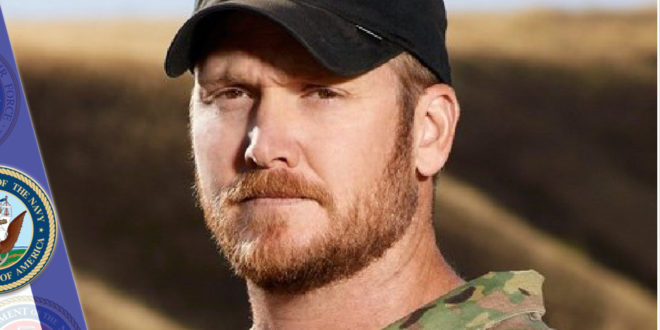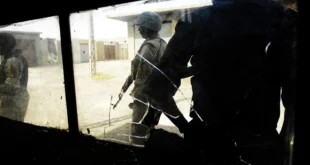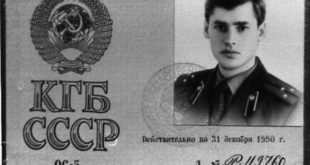Sniper Chris Kyle wrote the following for Soldier of Fortune in 2012, the year before he was killed. More than a decade later, his words resonate.
Tested
I was not the best sniper in my class. In fact, I failed the practice test. That meant potentially washing out of the class.
Unlike the Marines, in the field we don’t work with spotters. The SEAL philosophy is, basically, if you have a fellow warrior with you, he ought to be shooting, not watching. That said, we did use spotters in training.
After I failed the test, the instructor went through everything with my spotter and me, trying to figure out where I’d gone wrong. My scope was perfect, my dope was set, nothing was mechanically wrong with the rifle.
Suddenly, he looked up at me.
“Dip?” he said, more a statement than a question.
“Oh . . .”
I hadn’t put any chewing tobacco in my mouth during the test. It was the only thing I’d done differently, and it turned out to be the key. I passed the exam with flying colors—and a wad of tobacco in my cheek.
Snipers as a breed tend to be superstitious. We’re like baseball players with our little rituals and must-dos. Watch a base¬ball game, and you’ll see a batter always does the same thing as he steps to the plate—he’ll make the sign of the cross, kick the dirt, wave the bat. Snipers are the same way.
During training and even afterward, I kept my guns a certain way, wore the same clothes, had everything arranged precisely the same. It’s all a matter of controlling everything on my end. I know the gun is going to do its job. I need to make sure I do mine.
There’s a lot more to being a SEAL sniper than shooting. As training progressed, I was taught to study the terrain and the surroundings. I learned to see things with a sniper’s eye.
If I were trying to kill me, where would I set up? That roof. I could take the whole squad from there.
Once I identified those spots, I’d spend more time looking at them. I had excellent vision going into the course, but it wasn’t so much seeing as learning to perceive—knowing what sort of movement should get my attention, discerning subtle shapes that can tip off a waiting ambush.
I had to practice to stay sharp. Observation is hard work. I’d go outside and just train myself to spot things in the distance. I always tried to hone my craft, even on leave. On a ranch in Texas, you see animals, birds—you learn to look in the distance and spot movement, shapes, little inconsistencies in the landscape.
For a while, it seemed like everything I did helped train me, even video games. I had a little handheld mahjongg game that a friend of mine had given us as a wedding present. I don’t know if it was exactly appropriate as a wedding present—it’s a handheld, one-person game—but as a training tool it was invaluable. In mahjongg, you scan different tiles, looking for matches. I would play timed sessions against the computer, working to sharpen my observation skills.
I said it before and I’ll keep saying it: I’m not the best shot in the world. There were plenty of guys better than me, even in that class. I only graduated about middle of the pack.
As it happened, the guy who was the honor man or best in our class was part of our platoon. He never had as many kills as I did, though, at least partly because he was sent to the Philippines for a few months while I spent my time in Iraq. You need skill to be a sniper, but you also need opportunity, and luck.
Guns
People ask a lot about weapons, what I used as a sniper, what I learned on, what I prefer. In the field, I matched the weapon to the job and the situation. At sniper school, I learned the basics of a range of weapons, so I was prepared not only to use them all but also to choose the right one for the job.
I used four basic weapons at sniper school. Two were magazine-fed semiautomatics: the Mk-12, a 5.56 sniper rifle; and the Mk-11, a 7.62 sniper rifle. Then there was my .300 Win Mag. That was magazine-fed, but it was bolt-action. Like the other two, it was suppressed, which means that it has a device on the end of the barrel that suppresses muzzle flash and reduces the sound of bullet as it leaves the gun, much like a muffler on a car. I also had a .50 caliber, which was not suppressed.
Let’s talk about each weapon individually.
Mk-12
Officially the United States Navy Mk-12 Special Purpose Rifle, this gun has a 16-inch barrel, but is otherwise the same platform as an M-4. It fires a 5.56 x 45mm round from a 30-round magazine. It can also be fitted with a 20-round box.)
Derived from what became known as the .223 cartridge and therefore smaller and lighter than most earlier military rounds, the 5.56 is not a preferred bullet to shoot someone with. It can take a few shots to put someone down, especially the drugged-up crazies we were dealing with in Iraq, unless you hit him in the head. Contrary to what you’re probably thinking, not all sniper shots, certainly not mine, take the bad guys in the head. Usually I went for center mass—a nice, fat target somewhere in the middle of the body, giving me plenty of room to work with.
The gun was super-easy to handle and was virtually inter¬changeable with the M-4 which, though not a sniper weapon, is still a valuable combat tool. As a matter of fact, when I got back to my platoon, I took the lower receiver off my M-4 and put it on the upper receiver of my Mk-12. That gave me a collapsible stock and allowed me to go full-auto.
On patrol, I like to use a shorter stock. It’s quicker to get up to my shoulder and get a bead on somebody. It’s also better for work¬ing inside and in tight quarters.
Another note on my personal configuration: I never used full-auto on the rifle. The only time you really want full-auto is to keep someone’s head down; spewing bullets doesn’t make for an accu¬rate course of fire. But since there might be a circumstance where it would come in handy, I always wanted to have that option in case I needed it.
Mk-11
Officially called the Mk-11 Mod X Special Purpose Rifle and also known as the SR25, this is an extremely versatile weapon. I particularly like the idea of the Mk-11 because I could patrol with it (in place of an M-4) and still use it as a sniper rifle. It didn’t have a collapsible stock, but that was its only drawback. I would tie the suppressor onto my kit, leaving it off during the start of a patrol. If I needed to take a sniper shot, I would put it on. But if I was on the street or moving on foot, I could shoot back right away. It was semiautomatic, so I could get a lot of bullets on a target. It fired 7.62 x 51mm bullets from a 20-round box. Those had more stopping power than the smaller 5.56mm rounds. I could shoot a guy once and put him down. Our rounds were match-grade ammo bought from Black Hills, which makes probably the best sniper ammo around.
The Mk-11 had a bad reputation in the field because it would often jam. We wouldn’t have jams that much in training, but over¬seas was a different story. We eventually figured out that some¬thing to do with the dust cover on the rifle was causing a double feed; we solved a lot of the problem by leaving the dust cover down. There were other issues with the weapon, however, and personally it was never one of my favorites.
The .300 is in another class entirely. As I’m sure many readers know, .300 Win Mag (pronounced “three hundred win mag”) refers to the bullet the rifle fires, the .300 Winchester Magnum round (7.62 x 67mm). It’s an excellent all-around cartridge, whose performance allows for superb accu¬racy as well as stopping power. Other services fire the round from different (or slightly differ¬ent) guns; arguably, the most famous is the Army’s M-24 Sniper Weapon System, which is based on the Remington 700 rifle. In our case, we started out with MacMillan stocks, customized the bar¬rels, and used the 700 action. These were nice rifles.
In my third platoon—the one that went to Ramadi—we got all new .300s. These used Accuracy International stocks, with a brand-new barrel and action. The AI version had a shorter barrel and a folding stock. They were bad-ass.
The .300 is a little heavier gun by design. It shoots like a laser. Anything from a thousand yards and out, you’re just plain nailing it. On closer targets, you don’t have to worry about too much correction for your come-ups. You can dial in your 500-yard dope and still hit a target from 100–700 hundred yards without worrying too much about making minute adjust¬ments. I used a .300 Win Mag for most of my kills.
.50 Caliber
The fifty is huge, extremely heavy, and I just don’t like it. I never used one in Iraq. There’s a certain amount of hype and even romance for these weapons, which shoot a 12.7 x 99mm round. There are a few different specific rifles and variations in service with the U.S. military and other armies around the world. You’ve probably heard of the M-82 or the M-107, developed by Barrett Firearms Manufacturing. They have enormous ranges and in the right application are certainly good weapons. I just didn’t like them all that much. (The one .50 I do like is the Accuracy International model, which has a more compact, collapsible stock and a little more accuracy; it wasn’t available to us at the time.)
Everyone says that the .50 is a perfect anti-vehicle gun. But the truth is that if you shoot the .50 through a vehicle’s engine block, you’re not actually going to stop the vehicle. Not right away. The fluids will leak out and eventually it will stop moving. But it’s not instant by any means. A .338 and even a .300 will do the same thing. No, the best way to stop a vehicle is to shoot the driver, and that you can do with a number of weapons.
.338 Lapua
We didn’t have .338s in training; we started getting them later on during the war. Again, the name refers to the bullet; there are a number of different manufacturers, including MacMillan and Accuracy International. The bullet shoots farther and flatter than a .50 caliber, weighs less, costs less, and will do just as much dam¬age. They are awesome weapons.
I used a .338 on my last deployment. I would have used it more if I’d had it. The only drawback for me was my model’s lack of a suppressor. When you’re shooting inside a building, the concussion is strong enough that it’s a pain, literally. My ears would hurt after a few shots.
Since I’m talking about guns, I’ll mention that my current favorites are the weapons systems made by GA Precision, a very small company started in 1999 by George Gardner. He and his staff pay close attention to every detail, and his weapons are just awesome. I didn’t get a chance to try one until I got out of the service, but now they’re what I use.
Scopes are an important part of the weapon system. Overseas, I used a 32-power scope. Additionally, depending on the circumstances, I had an infrared and visible red laser, as well as night vision for the scope.
As a SEAL, I used Nightforce scopes. They have very clear glass and they’re extremely durable under terrible conditions. They always held their zero for me. On deployments, I used a Leica range finder to determine how far I was from a target.
Most of the stocks on my guns used adjustable cheek-pieces. Sometimes called a comb (technically, the comb is the top piece of the stock, but the terms are sometimes interchanged), the extension let me keep my eye in position when sighting through the scope. On older weapons, we would adapt a piece of hard-packed foam and raise the stock to the right height. (As scope rings have gotten larger and more varied in size, the ability to change the stock height has become more important.)
I used a two-pound trigger on my rifles. That’s a fairly light pull. I want the trigger to surprise me every time; I don’t want to jerk the gun as I fire. I want no resistance: Get set, get ready, put my finger and gently start squeezing, and it goes off.
As a hunter, I knew how to shoot, how to make the bullet go from point A to point B. Sniper school taught me the science behind it all. One of the more interesting facts is that the barrel of a rifle cannot touch any part of the stock: they need to be free-floating to increase accuracy. When you shoot a round, a vibration comes through the barrel, known as barrel whip. Anything touching the barrel will affect that vibration and, in turn, affect the accuracy. Then there are things like the Coriolis effect, which has to do with the rotation of the earth and the effect it has on a rifle bullet. This comes into play only at extremely long distances.
You live all of this technical data in sniper school. You learn about how far to lead someone when they’re moving—if they’re walking, if they’re running, depending on the distance. You keep doing it until the understanding is embedded not just in your brain but in your arms and hands and fingers.
In most shooting situations, I adjust for elevation but not for windage. Simply put, adjusting for elevation means adjusting my aim to compensate for the drop of my bullet over the distance it travels; windage means compensating for the effect of the wind. The wind is constantly changing. So about the time I adjust for wind, the wind changes. Elevation is a different story. If you’re in a combat situation, a lot of times you don’t have the luxury of making a fine adjustment. You have to shoot or be shot.
 Soldier of Fortune Magazine The Journal of Professional Adventurers
Soldier of Fortune Magazine The Journal of Professional Adventurers






